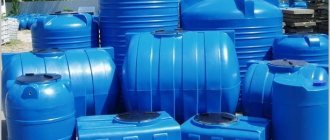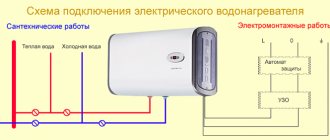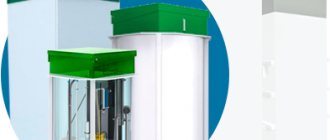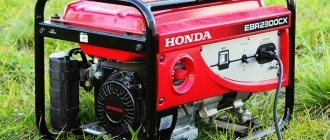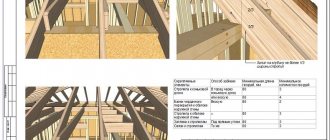The traditional solution for removing domestic water and sewage from a home is a gravity sewer system, in which waste, driven by gravity, flows and moves through pipes laid with a slope of at least 2%. From the plumbing fixtures they move to the riser, from where they are discharged into the external sewage system and redirected to a bio-treatment plant or another treatment facility. Nowadays, forced sewerage is increasingly helping to free up the hands of designers and homeowners. Pipes for waste disposal in the presence of a sololift have a very small diameter (from 16 to 45 mm), and the sololifts themselves have small dimensions and are easily hidden in the wall.
Disposal of domestic wastewater from the basement
The number of private country houses in our country, especially near large cities, is constantly growing.
Cottages, the share of which in the total volume of individual construction is quite large, as a rule, in addition to the usual living quarters and kitchen, “have” additional space. Most often, this is the attic and basement, or ground floor. The basement floor is the “big brother” of the basement, the subfloor, which strives to become a full-fledged floor. Owners of comfortable houses can successfully expand the usable area of their home by converting this initially non-residential premises into a “working” space. For example, in the basement you can organize household services or a gym. Thus, a common way of “developing” the basement floor in our time has become the installation of a sauna with a shower. In the basement, you can finally set up a home laundry room by installing a washing machine and dryer, as is customary, for example, in the USA. Times change
Until recently, among people who have ever dealt with the construction and renovation of country houses, there was a widespread opinion that it is not worthwhile to equip any premises related to water supply and sanitation in basements and semi-basements. And this was justified: the fact is that when operating, for example, a bathroom or toilet, the question of drainage inevitably arises. Most often it happens that the local or global sewer system is located above the level of drainage from the building. As a result, standard gravity-driven sewerage, common in urban housing, is not possible here. For forced pumping of drains from bathrooms and toilets into sewers or individual treatment facilities, if their level is higher than the outlet level, compact pumping stations are actively used today, providing preliminary accumulation and subsequent pumping of household wastewater. Such installations are usually similar to an ordinary toilet cistern. Their body is usually made of white impact-resistant plastic. Due to their compact size, such devices can be easily hidden behind the plumbing fixture to which they are connected. Thus, the aesthetic appearance of the bathroom, shower, sauna is not disturbed. The devices themselves are lightweight—weighing up to 7 kilograms—and are easy to install and operate. Among such installations we can highlight the Sololift+ station produced by GRUNDFOS. The unit accumulates liquid coming from the toilet or bathroom, and when the device is completely filled, the pump located inside automatically discharges water into the sewer network. At the same time, the drains can be raised to a height of more than two floors - up to 6.5 meters, and the maximum volume of water supply is 4 cubic meters per hour! It is quite enough to use the ground floor, as they say, to the fullest... To avoid possible clogging, the units attached to the toilet are equipped with a special grinder that can easily “recycle” fibrous and solid inclusions. Note that even if such a mechanism is available, it is worth following the simplest rules for using the sewer system - do not flush solid household waste and hygiene items down there! The station requires virtually no maintenance, as its design ensures self-cleaning when emptying. The installation has an vent with a carbon filter, which means there is no need to connect a ventilation pipe, and unpleasant odors will not be able to penetrate into the room.
Wash without problems
As already mentioned, the basement floor is an excellent place to organize a kitchen, home laundry, or bathroom. For convenience, it sometimes makes sense to use special devices - compact collection tanks equipped with pumps. This is relevant for those owners whose houses have the ability to connect to a collector, but it is located at a fairly large distance. First, the tank of such an installation is filled with water, and after it is “saturated,” the float device turns on the pump and the waste goes into the sewer system. The GRUNDFOS LIFTAWAY installations, used in conjunction with Unilift CC pumps, have proven themselves well in this role. Depending on the modification, such a device is mounted against the wall or under the floor. In the case of “underground” installation, the water supply is carried out through a cover mounted at the same level as the floor. Depending on the pump model, the device provides water supply from 8.5 to 24 cubic meters per hour with a pressure from 5 to 14.5 meters. The temperature of the pumped water can be up to 55 degrees Celsius, and for a short time the installation can withstand up to 70 degrees. This is a big plus, because very hot water is often drained from the washing machine or dishwasher, and in the kitchen it is impossible to do without it.
What's next?
After the “evacuation” of water from the premises, the question arises about the further fate of the wastewater. Several options are possible here: drainage of wastewater into a centralized or local sewer network, supplying it to an individual or general treatment plant, or draining it into storage tanks with subsequent removal by sewerage trucks. When organizing a treatment facility, it is possible to use several technologies: for example, natural biological purifiers are used. These include filter wells, irrigation fields, and sand and gravel filters. Water purification plants organized at such individual sewerage stations are usually divided into deep treatment stations, septic tanks with biofilters and septic tanks with post-treatment at the above-mentioned natural biological treatment facilities. Among the well-known manufacturers of such devices one can name, in particular, such companies as the Russian Albatross, EPK Ekmon, Rosvodconsulting, Plast Group, NPF Ecos, NPP Polikhim, and the German ones IFU Diffusions und Umwelttechnik GmbH, Friess GmbH, ABB Umwelttechnologien GmbH. Sewage is supplied to all these places through pipes from the house using, for example, special pumping stations or sewage pumps equipped with a cutting mechanism. Such brands of pipelines as UPONOR, WAVIN and a number of others have become widespread around the world. A pumping station, as a rule, is a storage tank made of polymer material, equipped with submersible pumps, pipelines made of polymers or stainless steel, and fittings. The station is fully automated, and its operation can be controlled from the control cabinet. Thus, with the use of modern technologies, you can fearlessly and, as they say, happily use basement floors and semi-basements to equip them with all sorts of “pleasant things” - a sauna, a mini-pool, a bathtub, a shower. Owners of country houses can be satisfied.
Advantages and disadvantages
- The predominant advantage of forced sewerage is the ability to locate sanitary facilities and household appliances in almost any chosen place in the home, regardless of the location of the riser.
- Autonomous wastewater treatment plants can now be installed anywhere in a suburban area, regardless of the slope of the area, and in a private house or apartment - at any height, regardless of the level of the riser inlet.
- The risk of congestion in the system is minimal.
- The silent operating device does not bother the owners.
- The equipment operates automatically, without requiring outside intervention.
- The design and small size of the housing make it easy to fit the pump into any decor, or hide it inside furniture or in a small wall niche.
- Small pipe diameter.
- Installs easily and quickly.
- A removable sealed lid in combination with a carbon filter prevents unwanted odors from entering the room.
- The power of the device allows you to move waste to a height of up to 9 meters and up to 100 meters horizontally.
Disadvantages - rather high price, complete dependence on the power source.
Sewerage installation in the basement of a private house
Owners of private country houses usually have to deal with laying internal sewerage in the basement. This happens when one or more water consumption points are located in the basement. This could be a shower, sauna, toilet or even a swimming pool. In any case, the removal of liquid household waste from the basement is difficult, since we are not talking about gravity transportation - it is necessary to forcibly raise the waste liquids to the level of the main sewer line. At the same time, care should be taken to ensure the reliability of the constructed system, because the returned wastewater poses a sanitary and hygienic hazard. How to properly install internal sewer networks in the basement, and what nuances to take into account, you will learn by reading the article and looking at the attached thematic photos.
Types of Domestic Sewage Drains
To make internal sewerage in the basement of a private house effective, you need to know about the characteristics and volumes of discharged liquids
To make the internal sewage system in the basement of a private house effective, while avoiding the installation of unnecessary pumps in this situation, you need to know about the characteristics and volumes of discharged liquids. They are usually divided into two types:
- moderately polluted;
- heavily polluted.
Significantly contaminated liquid household waste includes the contents of toilet bowls. They contain solid and fibrous particles, so to remove them upstairs from the basement you will need special pumps equipped with the function of grinding solids and greater throughput.
All other household liquids that can be discharged from swimming pools, showers, washing machines and other plumbing and household appliances located in the basement are classified as moderately contaminated. To transport them to the level of the main sewer pipe, conventional pumps with a storage tank are used.
The need to separate the disposal of heavily and moderately polluted wastewater
Before installing communications, it is necessary to analyze the ratio of the volumes of fecal wastewater and moderately polluted
Before installing pumping equipment and laying internal sewer lines in the basement of a private house, it is necessary to analyze the ratio of the volumes of fecal wastewater and moderately polluted wastewater.
If we assume that only a toilet is installed indoors (which is rare), it will be enough to install a sololift, a device of low power, but capable of removing liquids contaminated with feces. Sololift is a device consisting of a pump, a small storage tank and a mechanism that grinds feces. Typically, sololifts are designed to drain sewage only from the toilet, although now there are models to which you can connect another point that discharges a small volume of waste liquids (for example, a washbasin).
More often, in the basement room, in addition to the toilet, other water consumption points are installed that require waste water removal. In such a situation, the estimated water consumption should be calculated. If it does not exceed 0.7-1.0 m3 per day, a sololift (before installation, pay attention to the pump performance) or a small sewage pumping station can handle this volume.
Important! Nowadays it is not difficult to find a station on sale that can work with fecal wastewater. Such universal pumps eliminate the issue of separating liquids of different types when discharging them from the basement of a private cottage or house.
Sololifts
As noted above, sewerage can be organized using sololifts. They are selected according to the same principle as pumping stations. The sololift must have a grinding system. In addition, there is a volume in which wastewater accumulates.
Sololift is the same pumping station, but used for rough waste. At the same time, they are small in size, so the issue of installation is not so relevant. The units have several inlet pipes, so several elements of the system can be connected to it. But Sololift has a small volume, which imposes slight restrictions on pumping capabilities in a certain period of time.
Separated sewage system
Separate removal from the basement of fecal and relatively clean liquid is advisable in case of large volumes of the latter
Separate drainage of fecal and relatively clean liquid from the basement is advisable in the case of large volumes of the latter. If there are many water intake points installed in the basement floor, giving a large total volume of water disposal, two schemes for pumping waste water are possible. The first involves the installation of a small fecal pumping station for the toilet (sololift) and a separate pump for slightly polluted water. A similar scheme is shown in the photo
The second scheme is rational when there is a swimming pool inside the basement. It is more advisable to service it with a separate pump, while connecting the remaining points to a low-power pumping station capable of removing fecal contamination.
Combined disposal of various wastewater
The operation of a pumping station makes it possible to solve the simultaneous removal of sewage liquids from all points of water use
The situation when only one toilet is installed in the basement of a private house was discussed above. If there are several more relatively small points of water consumption that produce moderately contaminated water at the output, pumping stations are installed to remove wastewater from plumbing fixtures on the ground floor of a private country house. In design, they resemble a sololift device, with the difference that they are equipped with higher power pumps and a larger storage tank.
The operation of the pumping station makes it possible to solve the simultaneous removal of sewage liquids from all points of water use that are located in the premises of the basement floor. Some models are equipped with a system to counteract the reverse flow of the pumped liquid. The performance of such equipment is designed for a pumping volume of up to 10 m3 of wastewater per day, which usually satisfies the needs even in conditions of intensive use of plumbing fixtures.
Owners of private houses often express dissatisfaction with the high noise level of pumping stations during operation. Modern equipment is much quieter. In addition, to install pumping devices, closed niches are built and installed inside, so that the sound of the operating station does not bother anyone.
Operation, maintenance
The principle of operation of forced sewerage does not require any special measures. The work process occurs automatically; the user only needs to pay attention to changes in his behavior in time.
The sewage system with a pump requires periodic maintenance. It consists of removing deposits on the inner walls of the container and cleaning the chopper. It is necessary to free the surfaces from lime and fat deposits. In addition, the tank in the housing should be cleaned of bottom layers of sludge.
To clean the device, unplug it and remove the cover. Then detergent is poured inside. This is a product that decomposes organic deposits on all surfaces and parts of the pump. According to the instructions, after pouring you need to wait a certain time. When the dissolution of the sediment is completed, the lid is closed and the pump is connected to the power supply. After this, the internal cavity is washed. To do this, you need to flush the toilet several times and open the cold water tap to maximum. The cleaning agent will be removed and the pump can be used again for its intended purpose.
Prevention of return movement of discharged wastewater
When purchasing pumping stations for sewerage, be interested in their additional functions
The peculiarity of the basement system is its location relative to the main highway and communications of the upper floors of a private house, so there is always a risk of filling the pipes located below with sewer contents. This undesirable phenomenon can be prevented in two ways.
- Installation of pumping equipment. equipped with a mechanism to counteract the return of waste water. Many modern models are equipped with such capabilities, although not all. When purchasing pumping stations for sewerage, be interested in their additional functions, which will protect the basement of a private house from unpleasant situations.
- Installation of intermediate storage tanks (installed next to the house on the site) and installation of valve blocks in the outlet pipe to prevent the reverse movement of wastewater into the basement. The disadvantage of valve mechanisms is that blockages occur more frequently, so after installing the blocks you need to be prepared to clean them.
Experts often debate the advisability of protecting against retrograde movement of drains into the basement. Some believe that the installation of several levels of reverse current prevention is excessive, since this happens extremely rarely, and there is no point in extra costs. Others place sanitary safety above material costs. The truth, as always, is somewhere in the middle.
Thanks to modern pumping equipment, it is possible to remove the sewer from the basement by connecting to it an unlimited number of plumbing fixtures and other water consumers. Moreover, for this it is not necessary to build a ten-meter sewer well and lay pipes at great depths.
Operating principle
Thanks to technological progress, mechanisms called sololifts have appeared, which crush masses of waste and forcefully transport them through pipes of smaller diameter. As a result, users have the opportunity to “move” plumbing fixtures away from the riser and even place them below the discharge level into the external sewer system, where wastewater cannot leave the basement by gravity. The movement of waste is carried out forcibly, for which special electric fecal pumps are used - sololifts.
Drawing up a sewerage diagram for the basement
We recommend starting sewer wiring by drawing up a diagram that will display the horizontal lines of the entire floor or all floors, if the private house is multi-story. The diagram is drawn up from the distant location of the plumbing fixture. It is recommended to “assemble” the bathroom, kitchen and toilet onto one riser.
Such requirements will ensure normal gravity flow and allow the required operational slope to be maintained. In addition, it is necessary to exit the main riser into the ventilation duct. Let us recall that the level of the outlet device for the basement or ground floor is located above the level of the plumbing drain.
For sewerage of the premises in the basement, pumping stations are used, the devices of which have a significant throughput capacity and therefore guarantee the operability of the system. However, in practice it will be necessary to install the main sewer riser outlet.
Installation of sewer riser outlet
release device
The sewerage inlet into the basement and the sewerage outlet connect the in-house riser to the wastewater discharge point. The process of removing wastewater from the sewer system depends on the configuration of the outlet unit and its composition. Composition of the release device:
• pipes of internal and external networks
The specificity of the basement sewerage system is that the sewerage system of a private house has the following possible outlet locations:
• direct outlet through the basement floor
• release with system rotation above the floor and connection in another place
• the outlet is located above the basement floor.
Installation of a direct outlet through the basement floor begins with preparing a hole in the foundation or wall of the house. You can use an existing hole. The depth of installation of the exhaust system is from the blind area 0.7-2.0 m to the top of the pipe. A metal sleeve with a larger diameter than the pipeline is put on the pipe. The outlet is installed perpendicular to the plane of the house with a slope to a manhole or other structure.
The recommended distance to the well should be 3 meters. The release device is connected to the riser using two 45-degree elbows, and an inspection is installed on the riser located above the basement floor level.
How to lay sewer pipes is shown here.
Thus, competent and qualified internal sewerage wiring in the basement or basement will allow you to select the optimal connecting structure. Moreover, when building a private house, it is recommended to lay sewer pipes under the floor of the first floor.
fastening the sewer pipeline in the basement and plinth
For sewerage pipelines located in the plinth or basement, standard fasteners and embedded parts are used.
For laying on the floor, expanded clay concrete blocks up to 20 cm high are used, and the embedded parts are shot using brackets. Mobile racks with mounting clamps provide the required slope of the sewer pipeline.
To enter the sewer pipeline, stops are provided, which are placed in places where the plane turns vertical or horizontal to strengthen the pipe connections. So, for example, in the lower part of the sewer riser at the junction of: a two-plane cross, a tee and an expansion pipe ø110 mm, it will be necessary to install a common fastening with 2 clamps.
Pump - installation
Sewage equipment is a surface pumping installation for sewer systems, which makes it possible to transport wastewater in the absence of gravity sewerage. A powerful transfer pump is built into a small plastic housing with holes through which plastic pipes are connected. It is capable of pumping waste both horizontally and vertically. Installations are produced without a grinder - for so-called gray waste (from a shower tray, bathtub, washbasin, etc.). And with a grinder - for toilets and sinks.
Typically, toilet paper is processed using shredders. But some modifications are capable of processing more complex waste, such as gaskets. Such information is available in the product passport.
The plastic housing of the modification houses the pump itself, the filter system and the control element. A carbon filter is also inserted into the housing, which should be periodically washed with water. The device for the sewer system has an outlet pipe with a diameter of 100 mm. The pump itself is submerged, which makes its operation silent. A check valve is installed to ensure that waste does not return to its point of origin.
The equipment operates in the following sequence:
- Liquid leaves the plumbing fixture and flows through the inlet into the chamber with the pump. Sewage equipment can have up to 4 inlet openings. Consequently, up to four separate devices are connected to the sololift. However, first, several sources of waste located nearby can be combined and have one common drain pipe.
- A shredder is installed on the same shaft with the pump (in front of it), which destroys solid waste inclusions (food debris, wool or hair, etc.). Processing with a grinder transforms all this into an emulsion state. The chopper and pump axis are made of high-strength stainless steel.
- Next, the sololift passes the wastewater through filters and, using pressure, ensures its transportation through the pipes.
- When all the drains are pumped out, the engine, with input from the control element, turns off and “rests” until the moment when the container is filled and a signal to turn on is received from the level sensor.


